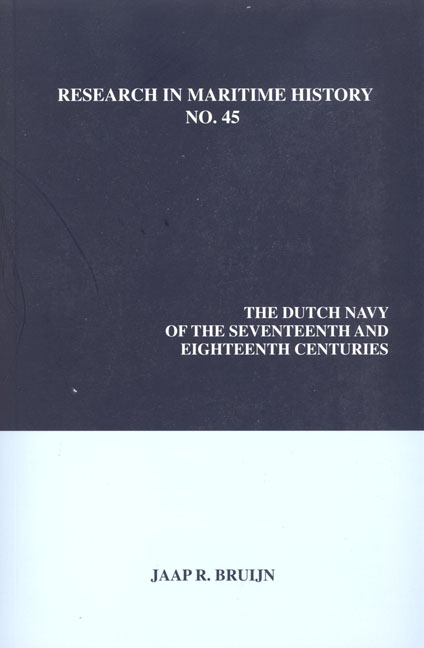Book contents
- Frontmatter
- Contents
- Illustrations
- Tables
- Series Editor's Foreword
- About the Author
- Introduction to the 2011 Edition
- Foreword
- Preface
- Introduction
- Map of the Dutch Republic
- Map of Dutch Naval Activity in European Waters
- Part One The “Old” Navy, Late 1500s-1652
- Part Two The “New” Navy, 1652-1713
- The “Old” Navy Out of Date
- John de Witt's New Navy
- An Era of Naval Campaigns against England and France and in the Baltic
- Changes in the Naval Administration
- De Ruyter and the Other Naval Officers
- Well-manned Ships
- Part Three A Second-Rate Navy, 1714-1795
- In Retrospect
- Bibliography
- Index
An Era of Naval Campaigns against England and France and in the Baltic
from Part Two - The “New” Navy, 1652-1713
- Frontmatter
- Contents
- Illustrations
- Tables
- Series Editor's Foreword
- About the Author
- Introduction to the 2011 Edition
- Foreword
- Preface
- Introduction
- Map of the Dutch Republic
- Map of Dutch Naval Activity in European Waters
- Part One The “Old” Navy, Late 1500s-1652
- Part Two The “New” Navy, 1652-1713
- The “Old” Navy Out of Date
- John de Witt's New Navy
- An Era of Naval Campaigns against England and France and in the Baltic
- Changes in the Naval Administration
- De Ruyter and the Other Naval Officers
- Well-manned Ships
- Part Three A Second-Rate Navy, 1714-1795
- In Retrospect
- Bibliography
- Index
Summary
Beginning in 1654, there was an interlude of several years when Dutch shipping was not threatened by any western or northern European power, much to the relief of the shipowners and their crews. It was a new feature of life at sea, since the continuous war against Spain and the Dunkirkers had been quickly followed by the first confrontation with England. Old hands from Tromp's navy who well remembered the endless struggle with the Dunkirk privateers during the Eighty Years’ War were now faced with a fiindamentally different pattern of naval operations. Only the usual scheme of regular convoys to and from France, the Iberian Peninsula, Italy and the Levant was maintained. At fixed times, a certain number of convoy escorts accompanied merchantmen to these destinations as a matter of routine, paid for out of the admiralties’ ordinary income.
Peace, however, is a relative notion for a seafaring country. Not every part of the European shipping lanes was free of hostilities. Moreover, the United Provinces had become one of the leading powers whose support was ardently sought by others and whose commercial, financial and military strength was a source of envy. England and France actively tried to diminish the Republic's power and influence. War against both countries required the commitment of all available resources, simply because great national interests - at times, even the territorial integrity of the Republic - were at stake. The menace to commercial interests in most cases required the attention of the main trading cities and the admiralties. John de Witt's navy was able to handle both of these contingencies.
The interests of Amsterdam mainly defined when and where naval power should be deployed in defence of trade and shipping. There were two areas of tension and risk: the Mediterranean and the Sound in the Baltic; the Dutch navy intervened in both areas.
One of the consistent elements of Dutch foreign policy was to act as the fulcrum in the balance of power between the Nordic states of Denmark and Sweden in order to prevent either one from controlling the Sound. When diplomacy failed, naval intervention was used, as in 1644 and 1645. It became unavoidable again in 1658, after Sweden's King Charles X, wanting the Baltic to be converted into a mare suedicum, had conquered much Danish territory, including the shores of the Sound.
- Type
- Chapter
- Information
- Publisher: Liverpool University PressPrint publication year: 2011



